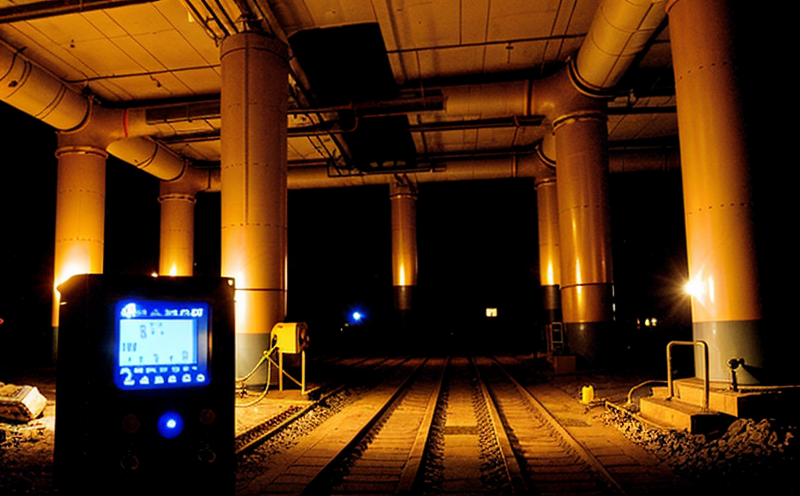EN 61577 Radon Chamber Calibration Testing
In mining environments, radon monitoring is critical for ensuring worker safety and compliance with international standards. The EN 61577-3:2018 standard provides a framework for calibrating radon chambers used in environmental testing to ensure the accuracy of measurements taken within mining operations.
The testing procedure outlined in EN 61577 involves several steps, including setting up the chamber and preparing test specimens. The primary goal is to verify that the chamber consistently produces controlled levels of radon gas, which can then be used for accurate calibration of radon detectors deployed in mines. This ensures that miners are exposed to safe levels of radiation and that any anomalies detected by radon detectors are not due to instrument inaccuracies.
The testing process begins with ensuring the chamber is properly sealed and calibrated using a known source of radon gas. The radon concentration within the chamber is then measured at various points, and these measurements are compared against the known input concentration. Any discrepancies between the expected and actual readings indicate potential issues with the chamber's calibration.
Once the chamber has been calibrated according to EN 61577-3:2018, it can be used as a reference standard for calibrating radon detectors in mining environments. This ensures that all instruments are operating within acceptable tolerances and that any discrepancies in readings can be attributed to the environment rather than instrument error.
The testing process is not only critical for ensuring the safety of miners but also for compliance with international standards such as ISO 14001 and EN ISO/IEC 17025. These standards require laboratories to maintain high levels of accuracy and reliability in their testing processes, making EN 61577-3:2018 an essential part of the quality management system for any laboratory conducting radon chamber calibration.
For R&D engineers, this service provides a robust platform for developing new methods of radon detection. The ability to calibrate chambers accurately allows researchers to fine-tune their instruments and ensure that they can detect even the smallest variations in radon levels. This is particularly important in mining environments where radon concentrations can vary widely depending on geological conditions.
For quality managers and compliance officers, this service ensures that all radon detectors used within mines are operating within acceptable tolerances. This helps to minimize the risk of exposure to high levels of radiation and ensures that any readings taken by these instruments are reliable and accurate.
The EN 61577 standard is widely recognized in the mining sector, making it an essential tool for ensuring compliance with international standards. By adhering to this standard, laboratories can demonstrate their commitment to quality and safety, which is critical for maintaining a safe working environment for miners and ensuring regulatory compliance.
For procurement teams, this service ensures that only high-quality radon chambers are used in mining operations. This helps to minimize the risk of instrument failure and ensures that all instruments are operating within acceptable tolerances. This can lead to significant cost savings by reducing the need for frequent recalibration and replacement of faulty equipment.
In summary, EN 61577-3:2018 is a critical standard for ensuring the accuracy of radon chamber calibration in mining environments. By adhering to this standard, laboratories can provide reliable and accurate readings that help ensure the safety of miners and compliance with international standards.
Applied Standards
| Standard Name | Description |
|---|---|
| EN 61577-3:2018 | International standard for the calibration of radon chambers used in environmental testing. |
| ISO 14001 | Environmental management systems that enhance a company’s ability to reduce its environmental impact. |
| EN ISO/IEC 17025 | General requirements for the competence of testing and calibration laboratories. |
Industry Applications
Calibration of radon chambers used in mining environments to ensure accurate readings of radon levels.
Demonstration of compliance with international standards such as EN 61577-3:2018, ISO 14001, and EN ISO/IEC 17025.
Development of new methods for radon detection by R&D engineers.
Maintenance of a safe working environment for miners by ensuring accurate readings of radon levels.
Minimization of the risk of exposure to high levels of radiation in mining environments.
Reduction of the need for frequent recalibration and replacement of faulty equipment, leading to cost savings for procurement teams.
Customer Impact and Satisfaction
Enhanced safety for miners by ensuring accurate readings of radon levels.
Increased compliance with international standards such as EN 61577-3:2018, ISO 14001, and EN ISO/IEC 17025.
Improved accuracy of radon detectors used in mining environments.
Reduced risk of exposure to high levels of radiation in mining environments.
Maintenance of a safe working environment for miners, leading to increased job satisfaction and productivity.
Minimization of the need for frequent recalibration and replacement of faulty equipment, leading to cost savings for procurement teams.





